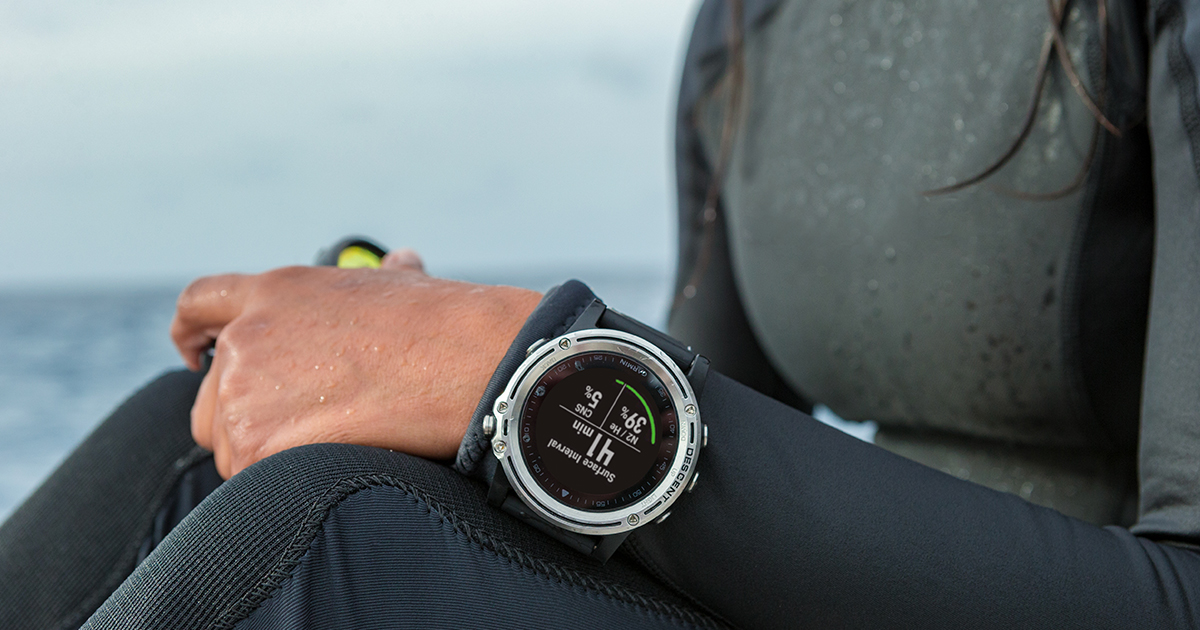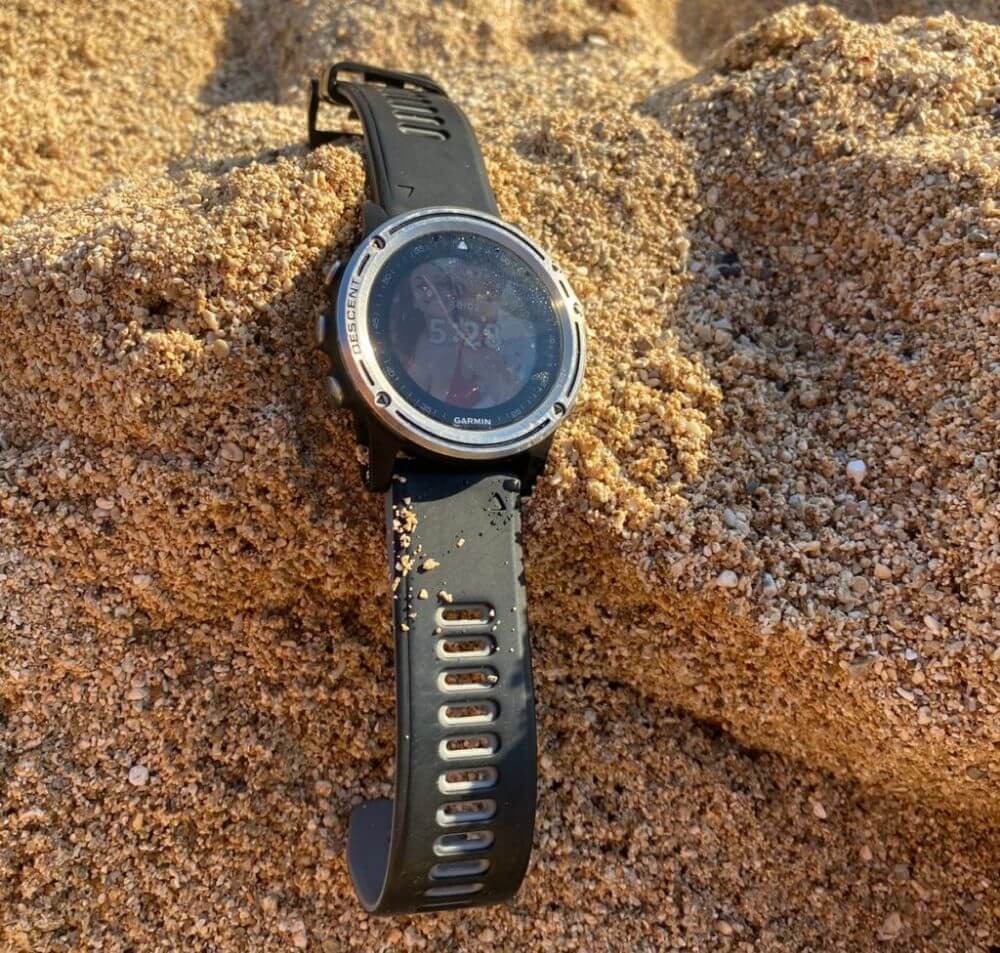
“This has got to be my favourite piece of dive equipment that I own – it has so many uses”! Gabby Abouhassan: Diving Squad Scout & Writer.
The Garmin Descent MK1 is quite different to the other candidates for the best dive computers we’ve reviewed.
For starters, it doubles up as a smart watch; featuring a heartbeat monitor and various sports modes. This is usually only seen in luxury dive computers, not mid-pricers like the Descent MK1!
Also, unlike most other dive computers, it features technical diving compatibility and the option to switch off the deco-lockout function.
As well as this, theres a digital compass, email and text syncing, GPS compatibility and a user-rechargeable battery with a huge life of 40 hours in dive mode and 19 days in watch mode!
Of course, no dive computer is perfect and the Garmin Descent MK1 definitely has room for improvement – largely in that it doesn’t have air integration.
(Fortunately the next model up: the Garmin Descent MK2i does have air integration and is an all-round better dive computer).
In this review, we’ll take an in-depth look at the Garmin Descent MK1 – it’s many features, functionalities and specs – whilst highlighting any shortcomings.
PROS:
- Smartwatch functions
- GPS Tracker
- Monitors heartbeat
- Huge battery life
- Watch-sized
- Full-colour, high definition LED display
- Comfortable silicon strap
- Durable
- Tech diving functionalities
- 6 modes
CONS:
- No Air Integration Option
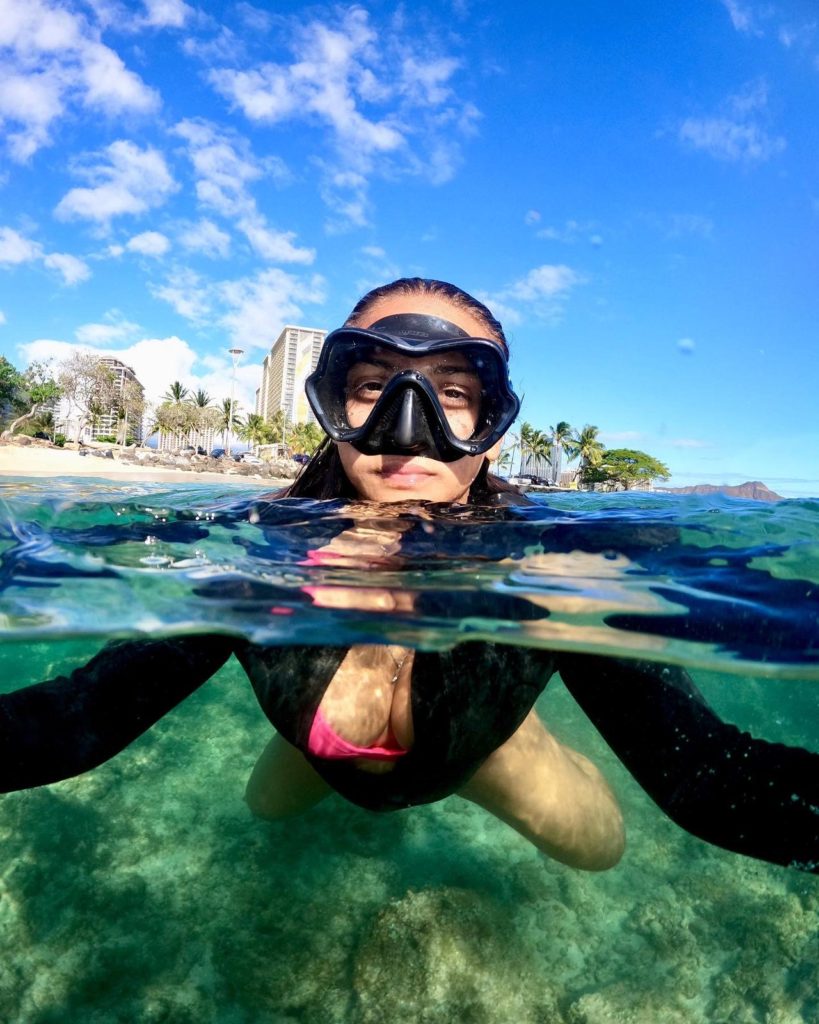
“This has got to be my favourite piece of equipment that I own – it has so many uses!
The Garmin Descent MK1 is more than just a dive computer – it also works as an awesome smart watch and can connect to your phone to show you when you’re receiving calls and texts.
It also doubles up as my compass, temperature gauge… depth gauge – and I can even even see gps on it as well. There’s just so many cool features and uses.
Without a doubt it is the best dive computer I’ve ever used – it may be a little expensive but it’s worth every penny to have such a versatile piece of equipment”!
Gabby Abouhassan: Diving Squad Scout & Writer.
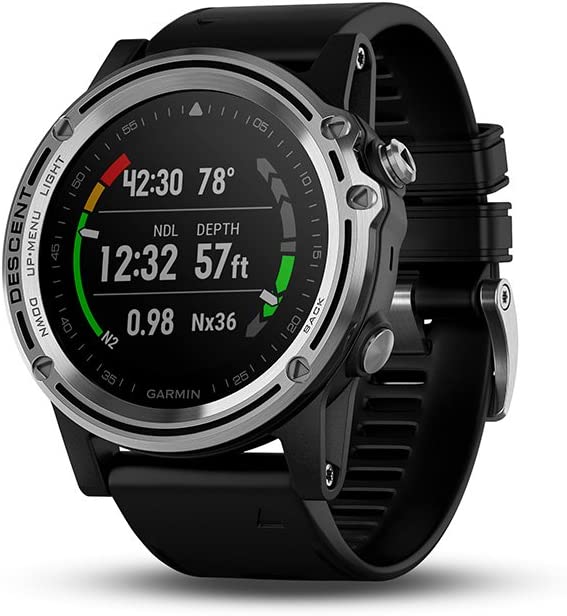
Features:
- Depth rating: 328ft / 100m
- Battery life: 40 hours dive mode / 19 days watch mode
- Bezel Diameter: 2inch / 51 mm (watch sized)
- Display Diameter: 1.2 inch / 30 mm
- Weight: 3.5 oz / 101 grams
- Dive Log: 200 Dives
- User Interface: Touch Screen
- Stainless steel bezel
- Silicone strap
- Google & Smart Watch App compatible
FEATURES:
1) Six Modes:
Whilst many dive computers only operate in 4 or 5 modes, the Garmin Descent MK1 features 6:
- Single-gas (aka air) for scuba diving with a regular tank of air.
- Multi-gas (aka nitrox) for nitrox and mixed gas diving.
- Apnea (aka freediving)
- Apnea hunt (for spearfishing) – this is the unusual mode that not many other dive computers have. Upon descent it automatically starts tracking and ends the dive upon reaching the surface.
- Gauge where the dive computer acts as a bottom timer, displaying time and depth but without a bottom time or no-deco limit.
- Plan calculates maximum time you can stay at a depth without requiring decompression stops.
Many dive computers only feature air, nitrox and freedive mode so it’s nice to see greater versatility with the Garmin Descent MK1. Granted , you’ll only need to use these extra modes if you’re spearfishing or tech diving…but if you are, they’ll definitely come in handy!
2) Buhlmann ZHL-16C Decompression Model:
A decompression model is the theoretical guidelines within which a diver must stay to avoid getting decompression sickness. It’s based on several factors – the dive profile (maximum dive-depth and how much time the diver stays at each depth, ascent rate etc), dive profiles over previous days and the decompression algorithm.
However – not all dive computers follow the same decompression algorithm – whilst the end-goal of all algorithms is the same: to keep the diver safe and free from decompression sickness, they vary slightly in terms of how they are calculated which in turn affects how conservative they are.
In the case of the Garmin Descent MK1 it operates via the Buhlmann ZHL-16C algorithm and also includes the modern gradient factors approach, which was first developed by one Erik Baker.
The Buhlmann ZHL-16C incorporates 16 theoretical tissue compartments with differing on and off gas rates. It is the speed of the off-gasing that determines how deep and how long each stop should be.
This is a well-known, moderately conservative algorithm that’s been in use for over three decades. Users have the option to customise it by applying different gradient factors which gives the option to configure stops to be where you want them to.
However, if that sounds over-complicated to you – don’t even sweat! The standard algorithm setting is ideal just the way it is.
You can also make more simple adjustments by switching between 3 conservatism settings. (More conservative = shorter bottom time and longer ascent time – it’s good for inexperienced divers or those with pre-existing medical conditions).
3) Five Button User Interface:
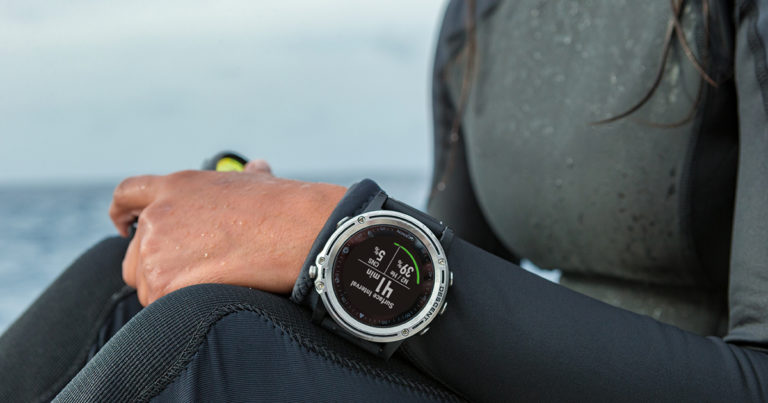
Generally speaking dive computers have 3 buttons or occasionally 4.
The Garmin Descent MK1 is quite unique for having a total of 5 buttons which makes it extra quick and efficient to scroll through the various settings and views.
Because it is also a smart watch, this is an extra useful feature – as you’ll probably be wanting to go through the various apps etc quite a lot. So, nice job Garmin!
The layout of apps and settings is straightforward and intuitive; any smartphone user will quickly get used to it.
Plus it can also be operated via a touchscreen! (A very unusual feature for a dive computer).
However do note, that the touchscreen is really for use when operating it on land as a smartwatch. When you are diving with the Garmin Descent MK1, the only touch-screen function is double tap for down scrolling. Everything else must be operated via the buttons when underwater.
4) LED Display:
The high-resolution, full colour LED display (1.2 inch diameter) is simply beautiful to gaze upon – its readings are incredibly clear and easy to read in all conditions. There is also a backlight, which you can adjust the brightness of.
For scratch resistance, the display is covered by a high domed sapphire lens.
5) Dive Log:
The dive log lets you store up to 200 dives on the dive computer which is certainly more than that of a cheap dive computer but fairly average as a dive log capacity for a mid-price dive computer.
You can share these dive logs and view them in greater detail via the Garmin connect and its included mobile app.
6) Smart Watch Functions:
Alright, finally! Sorry we took so long to get to the most defining part of the Garmin Descent MK1: its smart watch functions!
Said smartwatch functions include being able to check your emails and text messages, online apps and more. A favourite feature among users is the heart-rate monitor which operates both on land and underwater. Seriously awesome.
Doubling up as a smartwatch is a really cool trick for a dive computer but its rarely seen. And when it is present it’s almost always on luxury dive computers. The Garmin Descent MK1 is one of the cheapest dive computers of all time with smartwatch functionality.
7) Compass & GPS System:
The inbuilt 3-axis compass syncs up with the GPS system which automatically track and map your dive entry and exit points at the surface.
Compass headings can be set by the compass’ lubber line where you want to travel and then pressing a button. What’s really nice is that decompression info is still shown on the display even when you’re on compass mode – usually it’s not for dive computers with compasses.
8) Rechargeable Battery:
All cheap and most mid-priced dive computers have tiny lithium batteries which last for 150 – 200 dives before they need to be changed by someone with knowhow or after being sent of to the dive computer manufacturer service centre.
However, classier models – such as the Garmin Descent MK1 feature rechargeable batteries – simply plug it into the included cable and a power source and bam! In a couple of hours you’ll be fully charged and good to go…for 40 hours in dive mode and a whopping 19 days in watch mode.
This is a really impressive battery life – for comparison the Suunto D5 dive computer (which we think seriously rules by the way) has a battery life that only lasts for 12 hours in dive mode!
FINAL VERDICT:
We’re seriously impressed with the Garmin Descent MK1 which offers awesome value for money.
It is an extremely smart and stylish dive computer with fantastic smartwatch functions – especially the heart monitor and fitness modes!
We’re also huge fans of the inbuilt compass and GPS; especially the fact that they sync up so nicely!
One major downfall of the MK1 computer is the fact that it doesn’t have air integration – what the hell!? Even many cheap dive computers offer this feature.
Fortunately, it’s more expensive predecessor the Garmin Descent MK2 does have optional air integration.
